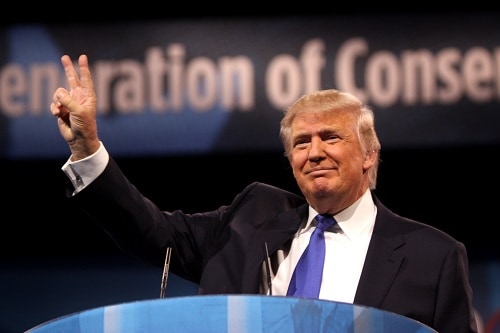
The Pharmafocus guide to the US presidential election 2016
pharmafile | October 20, 2016 | Feature | Business Services, Manufacturing and Production, Medical Communications, Research and Development, Sales and Marketing | US election, feature
The US presidential election is mere weeks away, and the pharmaceutical industry and drug pricing have occupied quite a large space in the debates. Originally published in the October issue of Pharmafocus, Sean Murray takes a look at an area that, surprisingly, Hillary Clinton and Donald Trump seem to agree on and the impact the new POTUS may have on the industry in the US and beyond.
For a pair that seem so ideologically opposed to each other, and on an extremely personal level at that, it may be surprising that there is one topic that Donald Trump and Hillary Clinton seem to share quite a lot of common ground on.
“Price gouging like this in the speciality drug industry is outrageous.” “Congress will need the courage to step away from the special interests and do what is right for America.” “It’s time to deal with skyrocketing out-of-pocket costs.” “When it comes to negotiate the cost of drugs, we are going to negotiate like crazy.”
While it may be obvious that the last quote certainly wasn’t said by Clinton, the other remarks echo a common theme that the presidential candidates have shared when it comes to discussing how they would deal with the issue of drug pricing and the pharmaceutical industry if they were elected president.
As recent events have shown us, the public appetite for some radical change on the issue is clear.
The new pantomime villain
While the execrable Martin Shkreli seemed to his enjoy his self-anointed “pharma bro” status as a symbol of everything that is wrong for the industry, Mylan CEO Heather Bresch doesn’t seem to be relishing her newest role as the latest pharma pantomime villain.
Bresch and Mylan have hit the headlines after the media latched onto some shocking figures surrounding the price increase of its EpiPen, an epinephrine autoinjector that is most often used for the treatment of anaphylaxis. Since she took on the role as CEO in 2008, the price of the EpiPen has quadrupled, while Bresch’s compensation has risen over 600%.
Being the daughter of a US senator did not make the Mylan CEO immune to political attack, with a wave of attacks coming from both wings. Already a vocal critic of pharma, democrat Bernie Sanders was among the first to weigh in: “The drug industry’s greed knows no bounds. There’s no reason an EpiPen, which costs Mylan just a few dollars to make, should cost families hundreds of dollars. The only explanation for Mylan raising the price by almost six times since 2008 is that the company values profits more than the lives of millions of Americans.”
A slew of politicians aimed criticisms at Bresch, with Clinton calling it “outrageous”. Commentators lined up to decry her as ethical attacks were joined by personal ones, as she endured a very public vilification. Her response in interviews – “No one is more frustrated than me. The system is broken” – did little to placate critics. Her attempt to criticise Obamacare and the wider US healthcare system led Slate’s Jordan Wiseman to ponder: “It all almost makes you miss Martin Shkreli; at least he was happy to own his villainy.”
Despite Mylan’s attempts at damage control, with pledges to cut the cost of EpiPen and widen access for children, the damage has indeed already been done. It may have already been in the works but the EpiPen scandal lead to Clinton publishing a wide ranging set of proposals on how to tackle drug pricing in the US. With prices of hepatitis C medicines and cancer drugs also seen as prohibitively high, it is a debate that has swept across America.
Bresch is certainly right about one thing, however. Mylan, however, is not a cause but a symptom of the wider problems facing health in the US. Can Clinton or Trump fix it? And, even with Clinton’s proposals, is there enough of a political appetite to get a job done?
A broken system?
The reasoning behind the US having higher drug prices than anywhere else is multi-faceted, to say the least. Branded drugs, for example, clearly have a large impact. According to a report from the Generic Pharmaceutical Association, brand name drugs account for 72% of drug spending in the US despite only comprising 10% of all dispensed prescriptions. And what makes the US unique in the high cost of its medicines?
Writing in JAMA, Kesselheim and colleagues explain: “Drug prices are higher in the US than in the rest of the industrialised world because, unlike that in nearly every other advanced nation, the US health care system allows manufacturers to set their own price for a given product.” Put quite simply, it is this fact that feeds into many of the issues plaguing the US healthcare system.
The researchers continue: “High drug prices are the result of the approach the US has taken to granting government-protected monopolies to drug manufacturers, combined with coverage requirements imposed on government-funded drug benefits.”
These factors aren’t just known by a scant few academics, these are widely available facts that have formed drug pricing debates for many years now. Critics point to other systems, even the UK’s own NICE system of appraisal, where costly therapies can be refused wide access as pointing to ways that the American model could shift in a way that was beneficial for patients and payers.
A recent Wall Street Journal feature compared the cost of a range of drugs under Medicare, and also under English and Norwegian health care systems. There are many examples to choose from. Bayer/Regeneron’s macular degeneration drug Eylea costs $919 per 2mg/0.05 ml vial in Norway, $1,159 in England and $1,936 under Medicare in the US.
It is easy to understand why figures like this, when shown as not an isolated case but part of a much wider trend, could anger the general public and provoke politicians into promising action on the issue. This, however, has not proved easy to remedy. While the US has a powerful pharmaceutical lobby, efforts to reform the private and public healthcare reimbursement systems has been met with opposition. On the one hand, conservatives in the US are loathe to meddle with industry and, on the other, pharmaceutical contribute millions in political donations each year.
The industry’s justification that highly-priced branded drugs merely reimburse them for their research and development costs, which in fairness can often run into the billions, the EpiPen and Daraprim controversies over generic drugs may signal a crisis point in the US healthcare system. Between 2008 and 2015 alone, the price of 400 generic drug products increased by more than 1000%. If the view of the industry was on a tipping point, then recent scandals have certainly pushed that over the edge.
In a frank assessment of the current view of the industry, White House press secretary Josh Earnest comments: “Pharmaceutical companies that often try to portray themselves as the inventors of lifesaving medication often do real damage to their reputation by being greedy and jacking up prices in a way that victimises vulnerable Americans.”
The presidential plan
It is clear that drugs companies are anticipating governmental action under the next administration. Novartis CEO, Joe Jimenez, told FT: “We believe that, no matter which candidate wins, we will see a more difficult pricing environment in the US. We all have to plan for new pricing models in the US that could help us ensure the sustainability of the system as the population ages.”
On Trump’s part, so far there have only been vague, sweeping statements on what he plans to do to affect the pharmaceutical industry if elected. One thing that particularly irks him is the strength of the pharmaceutical lobby. He is on the record as saying: “The drug companies probably have the second or third most powerful lobby in this country. They get the politicians, and every single one of them is getting money from them.” “We don’t do it (save billions in Medicare). Why? Because of the drug companies.”
One particular plan outlined on his campaign website will surely face bitter opposition from the pharmaceutical industry if he made attempts to implement it. It says: “Congress will need the courage to step away from the special interests and do what is right for America. Though the pharmaceutical industry is in the private sector, drug companies provide a public service. Allowing consumers access to imported, safe and dependable drugs from overseas will bring more options to consumers.” Removing the barriers that currently exist in the form of exclusivity will be easier said than done, however, and, to date, Trump has not outlined detailed plans on how to get this done.
Clinton has certainly been more proactive in outlining her pharma plans, especially in recent weeks. While campaign adverts over the past year have signalled her intent to combat “price gouging”, the plan outlined on her website is a detailed set of measures that have the potential to fundamentally change the pharmaceutical industry in the US, if they were all implemented, that is.

She plans to establish dedicated consumer oversight at public health and competition agencies, which will determine an unjustified, outlier price increase based on specific criteria including the trajectory of the price increase, the cost of production and the relative value to patients.
New enforcement tools will also be put in place, which include directly intervening to increase competition through the provision of alternatives, emergency importation of safe treatments and penalties for unjustified price increases to hold drug companies accountable and fund expanded access.
A Clinton statement says: “Hillary is offering an aggressive, immediate response plan to provide relief from unjustified drug price spikes for treatments, like EpiPens or pyrimethamine, that have long been on the market, where there has been little or no innovation or additional research and development.”
“In combination with her broader to agenda to lower prescription drug costs, which she is reiterating today, these strong new tools will ensure Americans can afford prescription drugs, and make sure that drug companies get ahead through innovation and research, rather than unjustified price increases.”
Both Clinton and Trump advocate access to high quality imported drugs to try and tackle high prices. Clinton goes even further however, pledging direct intervention to support generic and altnerative manufacturers to enter the market. And, crucially, she intends to allow Medicare to negotiate drug and biologic prices, as well as demand higher rebates for prescription drugs. Allowing Medicare to negotiate has the potential to significantly impact budgets in the US. Clinton believes she could save more than $100 billion in Medicare costs, with Trump having previously boasted a rather unrealistic-sounding $300 billion in savings.
Whether either of these figures can be achieved or not isn’t the main issue. The fact that it is such an important issue for both candidates makes it increasingly likely that such action may be taken under the next administration. With the Mylan scandal dominating the headlines, and the next scandal perhaps just around the corner, it is sure to be an important issue for Americans in the run-up to this election.
Pharma’s response
In an attempt to portray a different image of the industry, Allergan CEO Brent Saunders has taken the bold step of publishing his own manifesto regarding drug pricing and his company’s conduct going forward. It may be yet another response to the EpiPen scandal, but it is nevertheless a canny bit of PR on Allergan’s part. In it, he pledges to limit price increases on branded drugs to single digit percentages per year in most cases as well as never engaging in price gouging, calling it part of a “social contract” with the public.
Saunders says: “There is no joy on my part when a company finds itself in the public spotlight – the target of societal ire. I take comfort in reading about new treatments that improve and save lives. The public’s expectation is that we exist to heal and cure. It’s an expectation that mirrors our own.”
The perception of the industry in the US may be approaching an all-time low, but it is through interventions into the narrative of big bad pharma, like Saunders has done, that may yield great benefits. If more scandals follow, then Clinton or Trump affecting such policies will be widely supported.
With pressure on the industry increasing, it seems that the upcoming presidential election may finally bring about some real change to drug pricing in the country that pays more for its medicines that anywhere else in the world. The industry must adapt to the changing climate, or risk being left out of the conversation altogether.
Sean Murray
Related Content

Rare disease clinical trials: the urgent need for patients to be heard
Ahead of Clinical Trials Day, Soraya Bekkali, from Alexion, AstraZeneca Rare Disease, highlights the urgent …

Sustainability in pharma
Betsy Goodfellow from Pharmafocus considers the need for sustainable practices in the pharma industry and assesses various …

The November 2020 issue of Pharmafocus is available to read free online now!
The latest monthly edition of Pharmafocus is available to read for free online now!








